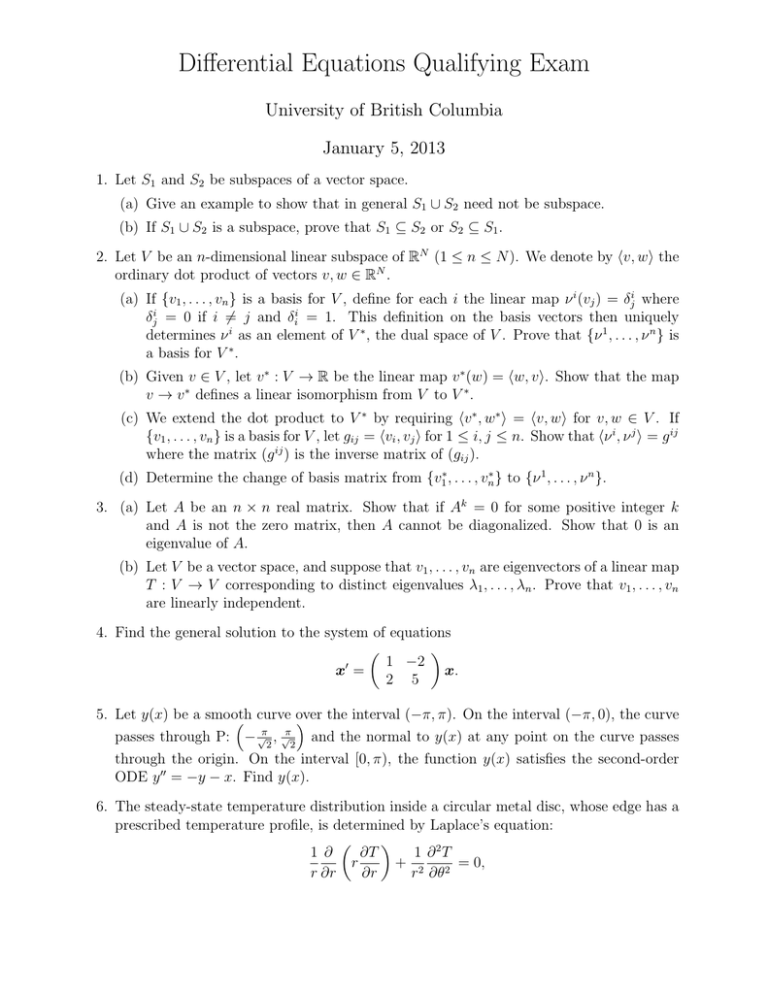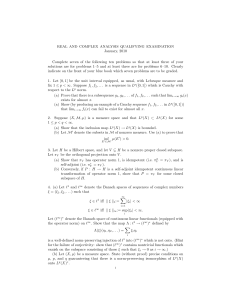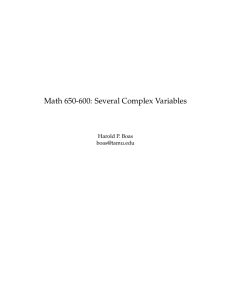Differential Equations Qualifying Exam University of British Columbia January 5, 2013
advertisement

Differential Equations Qualifying Exam
University of British Columbia
January 5, 2013
1. Let S1 and S2 be subspaces of a vector space.
(a) Give an example to show that in general S1 ∪ S2 need not be subspace.
(b) If S1 ∪ S2 is a subspace, prove that S1 ⊆ S2 or S2 ⊆ S1 .
2. Let V be an n-dimensional linear subspace of RN (1 ≤ n ≤ N ). We denote by hv, wi the
ordinary dot product of vectors v, w ∈ RN .
(a) If {v1 , . . . , vn } is a basis for V , define for each i the linear map ν i (vj ) = δji where
δji = 0 if i 6= j and δii = 1. This definition on the basis vectors then uniquely
determines ν i as an element of V ∗ , the dual space of V . Prove that {ν 1 , . . . , ν n } is
a basis for V ∗ .
(b) Given v ∈ V , let v ∗ : V → R be the linear map v ∗ (w) = hw, vi. Show that the map
v → v ∗ defines a linear isomorphism from V to V ∗ .
(c) We extend the dot product to V ∗ by requiring hv ∗ , w∗ i = hv, wi for v, w ∈ V . If
{v1 , . . . , vn } is a basis for V , let gij = hvi , vj i for 1 ≤ i, j ≤ n. Show that hν i , ν j i = g ij
where the matrix (g ij ) is the inverse matrix of (gij ).
(d) Determine the change of basis matrix from {v1∗ , . . . , vn∗ } to {ν 1 , . . . , ν n }.
3. (a) Let A be an n × n real matrix. Show that if Ak = 0 for some positive integer k
and A is not the zero matrix, then A cannot be diagonalized. Show that 0 is an
eigenvalue of A.
(b) Let V be a vector space, and suppose that v1 , . . . , vn are eigenvectors of a linear map
T : V → V corresponding to distinct eigenvalues λ1 , . . . , λn . Prove that v1 , . . . , vn
are linearly independent.
4. Find the general solution to the system of equations
1 −2
0
x =
x.
2 5
5. Let y(x) be a smooth
the interval (−π, π). On the interval (−π, 0), the curve
curve over
π
π
passes through P: − √2 , √2 and the normal to y(x) at any point on the curve passes
through the origin. On the interval [0, π), the function y(x) satisfies the second-order
ODE y 00 = −y − x. Find y(x).
6. The steady-state temperature distribution inside a circular metal disc, whose edge has a
prescribed temperature profile, is determined by Laplace’s equation:
1 ∂
∂T
1 ∂ 2T
r
+ 2 2 = 0,
r ∂r
∂r
r ∂θ
with boundary condition T (a, θ) = p(θ). Here r and θ are the polar coordinates, a is the
radius of the disc, and p(θ) is the prescribed edge temperature around the disc. Using
separation of variables, one can derive the following solution to Laplace’s equation on
the disc:
T (r, θ) =
∞
X
n=0
n
An r cos nθ +
∞
X
Bn rn sin nθ,
for 0 ≤ r ≤ a, −π < θ ≤ π.
n=1
(a) Determine the coefficients An and Bn so that the solution satisfies the boundary
condition at the edge T (a, θ) = p(θ).
(b) Use the above solution to show that temperature
R π at the center (r = 0) is equal to
1
p(θ) dθ.
the average around the edge: T0 = T (0, θ) = 2π
−π
(c) Use this mean value property to show that the maximum and minimum temperatures
on the disc occur on the boundary.
(d) The above property holds for elliptic partial differential equations in general, and is
known as the maximum principle. Use this principle to show that the solution to
Poisson’s equation,
∂T
1 ∂ 2T
1 ∂
r
+ 2 2 = q(r, θ),
r ∂r
∂r
r ∂θ
with the boundary condition T (a, θ) = p(θ), is unique.
Page 2



